HPV infection in some oral diseases
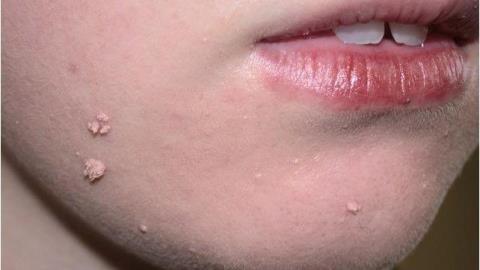
Oral HPV infection is caused by more than 40 different strains. How do they manifest? Article by Dr. Nguyen Quang Hieu
There are more than 140 strains of HPV that infect humans. Each strain will parasitize and cause disease in a certain area of the body. Some diseases are caused by HPV infection of the mouth and oropharynx. They form a group of diseases with distinct symptoms. So what do you know about oral HPV infection? Find out through the article below.
content
1. Skin warts
Skin warts come in many forms, such as
1.1 Acne has facial skin
Skin warts are also caused by a strain of HPV . The disease causes discomfort because it can float in some unwanted or "sensitive" locations.
The disease may have a single nodule or multiple nodules or a large papule on the skin. There are many measures to treat this problem, however, when not treated properly, the disease is easy to spread to the surrounding skin.
The treatment methods used are cauterization, electrocautery, CO2 cryotherapy, ablation of the lesion.
Do not self-treat. Self-treatment can spread these warts or cause infection, necrosis of the skin.
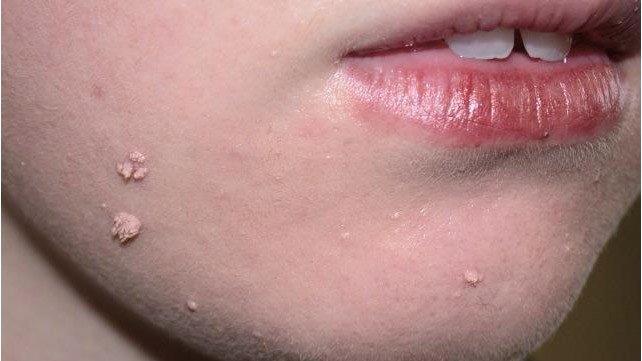
Warts on the skin of the face
1.2 Warts around the mouth
This strain is usually spread among people who are sexually active.
Their characteristic is: easy to spread. Grows in solitary nodules or clusters (usually less than 6 lesions). Appears around the mouth and mucous membranes of the lips. The wound can swell or ulcerate, causing infection and pain for the patient.
The disease is usually self-limited and disappears within 6 months. If you have a lot of warts, your doctor may advise you to burn the warts. Do not cut yourself or self-treat at home.
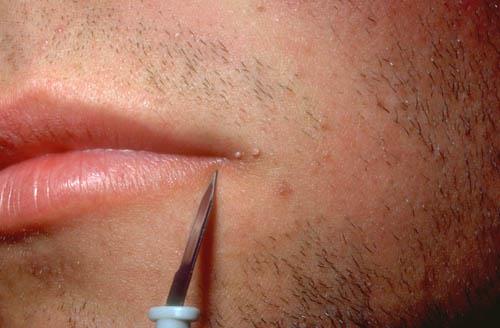
Warts around mouth
2. Genital warts
Genital warts are skin lesions caused by the HPV virus. This is perhaps the most described and well-known, as well as well-known, disease of HPV. These lesions are small pale pink or cauliflower-like papules that may initially be as small as a pinhead or may progress to large masses.
All epithelium of a sloughed wart lesion contains HPV. Therefore, HPV can be easily transmitted and cause disease on the skin and mucous membranes that have direct contact with the lesion.
There are many specific disease sites in the oral region such as:
2.1 Genital warts on palate, oral mucosa and pharynx
The disease is usually transmitted by oral sex activities or sharing oropharyngeal tools such as tongue scrapers, toothbrushes, etc. The strains that cause oropharyngeal disease are often classified as high-risk groups for regional cancer. mouth in special geographical groups. These groups of people include:
Symptoms are often obvious and overwhelming: Difficulty swallowing, persistent ear pain, coughing up blood, unexplained weight loss, enlarged oropharyngeal lymph nodes, pain, persistent sore throat, lump on cheek growing or lump on neck, hoarse voice.
If you have any suspicious signs, you need to see a doctor for an accurate diagnosis and treatment.
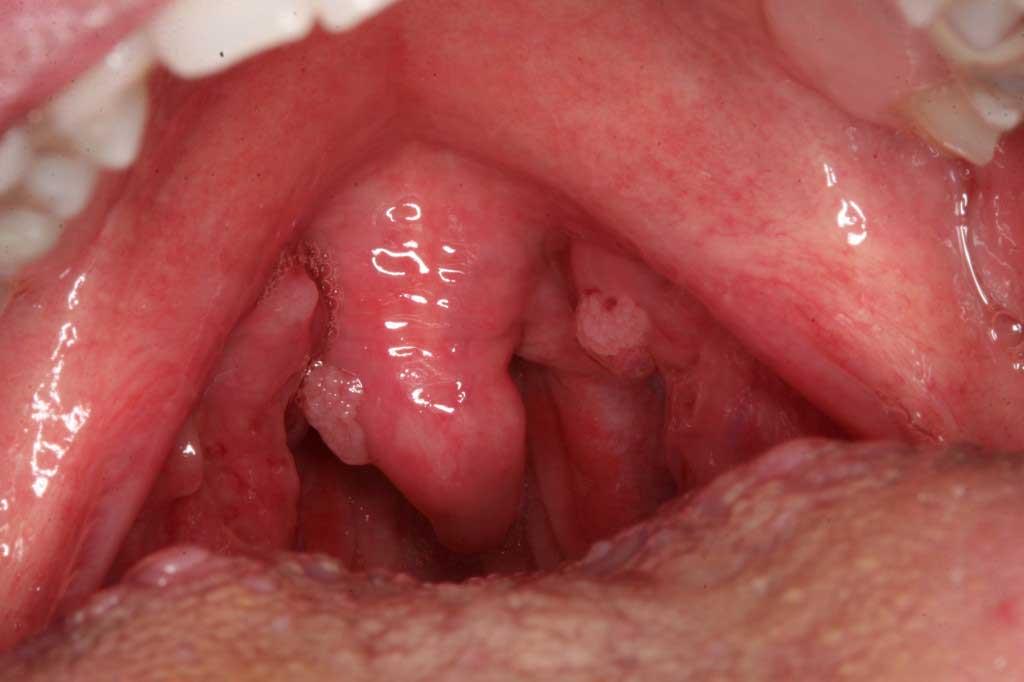
HPV lesions in the form of cauliflower in the oropharynx
2.2 Genital warts on the tongue – soft palate
The tongue area is the main "active" area for kissing and oral sex. Tongue is very vulnerable to damage and micro-injury when in contact with sharp objects. Accidental areas of skin when kissing such as the beard or just shaved areas can potentially damage your tongue without you noticing. Stimulating movements such as "love bites" can also inadvertently cause damage to the lips and tongue. The part of saliva and secretions on contact is deposited in the lower part of the oral cavity. The sublingual area is a prime example.
Therefore, this is the most common form of oral HPV infection . The treatment is simple with cryotherapy or laser. However, the subsequent treatment is often painful and takes a long time to heal, affecting the patient's eating and drinking.
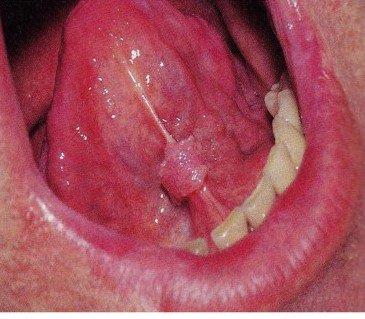
HPV causes warts under the tongue
2.3 Genital warts in the esophagus
This is considered a rather special form. Only about four strains of HPV can cause disease in this region. The cause is that a healthy person swallows secretions containing HPV from an infected person with previous pharyngitis or microscopic lesions in the esophagus.
Most patients present in the esophageal region rarely detected. The disease was incidental during esophagoscopy. Most warts caused by HPV are small in size. Large warts cause compression or difficulty swallowing when patients have specific immune problems. The patient's immunity is weakened when:
Esophageal warts are often difficult to treat.
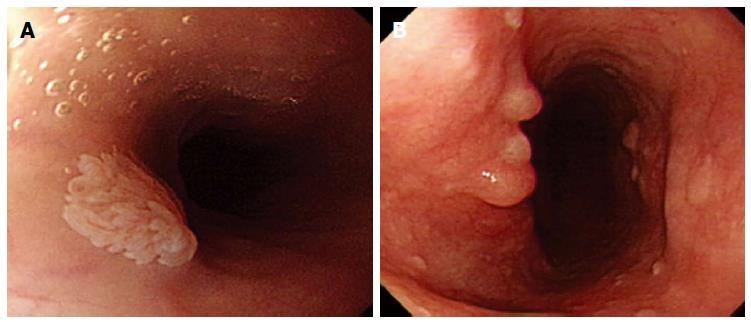
HPV infection in the mouth and esophagus
3. Multifocal epidermal proliferation
Some strains of HPV prefer a certain area of the body to show the disease. In which, there are more than 10 strains causing multifocal epidermal proliferative lesions in the face.
Worryingly, strains in the facial skin area spread quickly and easily spread into tiny, very unsightly spots.
Laser therapy can help patients with this problem. However, these strains often recur as your health declines. After an illness, HIV infection, immunodeficiency, organ transplant, allergies, etc. can all cause them to recur and spread.
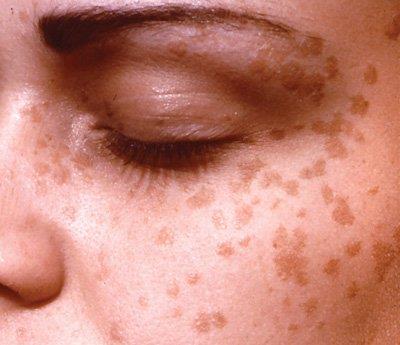
Multifocal epidermal hyperplasia of the face
3. Oral leukoplakia
The HPV virus also causes lesions in the oral mucosa but is quite rare. Leukoplakia lesions are red or white macules with a flat, smooth, firm surface, usually occurring on the floor of the mouth.
This manifestation is quite rare and especially rare in HPV. Leukoplakia is often associated with the EBV virus (Estern-Barr Virus). And leukoplakia caused by EBV carries a very high risk of oral cancer. Oral leukoplakia is considered a precancerous marker. Therefore, when detecting abnormalities in the mouth, see a doctor immediately for an accurate determination.
The doctor will take a small mucosal sample, at the edge of the lesion, and examine it under a microscope. If this tissue sample shows signs of dysplasia or cancer, you will have the necessary treatment plans in place. If you are determined to have no abnormalities, you will be scheduled by your doctor to see you in the following months with a follow-up schedule. You can rest easy because this is a rare disease in HPV. Only 4% turned cancerous in this case.
4. Oral cancer
This cancer includes cancers around the mouth and oropharynx.
These are the two most severe forms of the disease that HPV can cause. Cancers are associated with a number of predisposing factors, in addition to HPV infection. These factors are related to living habits. Examples include smoking and regular alcohol use.
4.1 Signs of oral cancer
The disease has many suggestive signs such as:
When you have the above symptoms, you need to go to a reputable medical facility. The doctor will examine and recommend the necessary tests to determine the disease accurately.
See more: Learn about HPV test
4.2 Treatment measures for oral cavity cancer
Depending on the stage of oral cancer , there are different treatment methods such as:
Diagnosing oral or nasopharyngeal cancer is often difficult and time-consuming. However, the disease progresses rapidly and is quite severe. They often reduce the patient's quality of life rapidly.
5. How to diagnose oral HPV?
Most patients will notice abnormalities in this area very easily. That prompts them to immediately go to the doctor.
In addition, abnormalities when infected with HPV in the mouth will make you immediately recognize when eating or drinking.
When you have these abnormalities, you should see a doctor. The diagnosis is quite simple. The symptoms of HPV are quite specific and can only be diagnosed by an experienced physician, without the need to use other tests. Depending on the area of the disease, the doctor will give you the right solutions and treatments.
There are many different strains of HPV, each of which causes disease in a different area of the skin. Oral HPV infection is caused by about 40 strains of HPV. When there are suspected abnormalities related to oral HPV infection, you need to see a doctor for proper diagnosis and treatment.
Oral HPV infection is caused by more than 40 different strains. How do they manifest? Article by Dr. Nguyen Quang Hieu
Doctor Le Duong Linh's article provides answers to the question, Is chronic cervicitis dangerous, symptoms and treatment?
